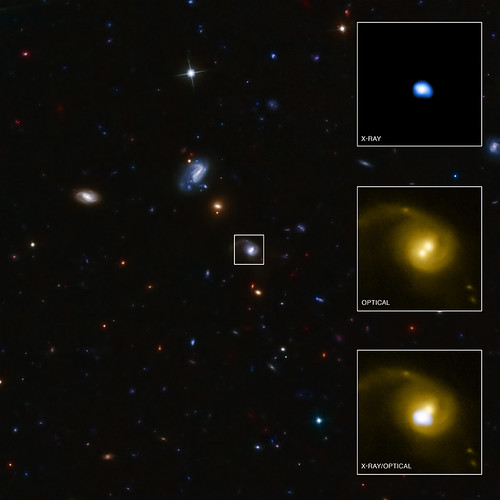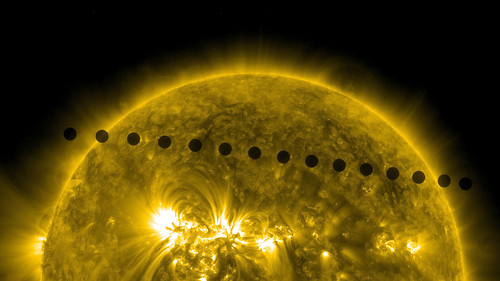Awesomeness Round-Up – 6/11/2012
- By Alexe Helmke
- June 11, 2012
- 5 Comments
On Tuesday, June 5, Venus passed in front of the Sun – an event that was visible on seven continents for those that were fortunate enough to have clear weather. These “transits” of Venus are very rare, coming in pairs separated by more than a hundred years. This June’s transit, the second of a 2004-2012 pair, won’t be repeated until the year 2117.

Credit: JAXA/NASA/Lockheed Martin
The first image is a composite of images taken by the Solar Dynamics Observatory that shows the path that Venus took across the disk of the Sun. The second is a close-up image taken by Hinode – a joint JAXA/NASA mission to study the connections of the sun’s surface magnetism, primarily in and around sunspots.

Credit: X-ray: NASA/CXC/SAO/F.Civano et al; Optical: NASA/STScI; Optical (wide field): CFHT, NASA/STScI
Recent observations from NASA’s Chandra X-ray Observatory suggest that a black hole may be in the process being kicked out of its host galaxy! It is thought that this black hole may have collided and merged with another black hole and then received a strong kick-back from gravitational wave radiation (theoretical ripples in the fabric of space predicted by Einstein), making it travel away from the center of the galaxy at three million miles per hour. The image above is of System CID-42, located about four billion light years away. In both the optical and X-ray/optical images you can see the two bright spots that mark the disks of matter spiraling down into the black holes.
Although this kind of event is probably very rare, it means that there could be many black holes floating in the voids between galaxies – and they would be invisible to us. We can observe the positions of black holes from bright disks of material that are falling into the black hole. However, if the black hole has been ejected from its host galaxy, there would be no gas around it lighting up for astronomers to observe. Since black holes emit no light on their own by nature, we would not be able to see them.
How many other black holes are there floating in the space between galaxies that we don’t know about?

Credit: David W. Hogg, Michael R. Blanton, and the Sloan Digital Sky Survey Collaboration
An international team of astronomers using data from the European Space Agency’s (ESA) XMM-Newton satellite has identified a long-sought X-ray “echo” that promises a new way to probe supersized black holes in distant galaxies. Most large galaxies have a black hole at their center, which is surrounded by a disk of material that is falling toward it. When this matter falls in closer to the black hole, the galaxies center lights up, emitting billions of times more energy than the Sun. A mysterious and intense X-ray source near the black hole shines onto the disk’s surface layers, causing certain atoms to emit light. Astronomers have predicted that when the X-ray source near the black hole flared, the disk would brighten after a delay corresponding to how long the X-rays took to reach and illuminate it. Astronomers observing galaxy NGC 4151 (image above) – which is a powerful X-ray source – over the past several years have confirmed that they have, indeed, uncovered several X-ray echoes, confirming the reality of this “relativistic reverberation.”
Astronomers have uncovered patterns of light that appear to be from the first stars and galaxies that formed in the universe. The light patterns were hidden within a strip of sky observed by NASA’s Spitzer Space Telescope. The top panel show’s Spitzer’s initial infrared view of this patch, including foreground stars and a confusion of fainter galaxies. In the lower panel, all of the resolved stars and galaxies have been masked out of the image (grey patches), and the remaining background glow has been smoothed and enhanced. This processing reveals structure too faint to be seen in the original image. This lower panel matches what we would expect for the patterns of star clusters from the first galaxies formed in the universe. These observations help confirm that the first objects were numerous in quantity and tremendously bright. Even though any particular early galaxy would be too faint to see individually, this technique allows astronomers to better understand what things were like shortly after the Big Bang.
Spitzer’s observations are laying the groundwork for the up-and-coming James Webb Space Telescope, which will hopefully tell us much more about the very early universe.





There is so much awesomeness in this roundup!!
Wow! The mechanics of huge objects like black holes are just fascinating! And it’s always exciting to hear that we’re finding out more about the early universe.
Nicely done, Alexe!
Larry is quite proud!
Enjoy your time in D.C..
All the Best,
Steve & Laurie (Judy’s neighbors)
So amazing! Thanks for an explanation I can almost understand!
Alexe, I am in awe of what you are doing & writing. I feel as if I’m not even qualified to read it, but read it I did and you wrote in such a way that I understood…a little bit! :) Keep up the great work!